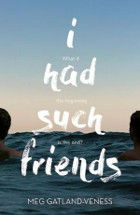I had such friends by Meg Gatland-Veness

Pantera Press 2018. ISBN 9781925700015
(Age: Teens) Themes: Death. Grief. Suicide. Bullying. Depression.
Prejudice. Love. Loneliness and coming of age issues. Homophobia.
Sexuality. Sexual identity. Abuse. Neglect. Alcoholism. Domestic
violence. Child sexual abuse. Self-confessed loser Hamish Day lives
with his parents on a small cabbage farm in an Australian seaside
town. His whole school is in shock after their top student, Charlie
Parker, is killed when his car swerved to avoid a dog; his
girlfriend, the also popular Annie Bower, survived the accident.
Hamish, also in year 12, wasn't friends with Charlie; his only
friend is Martin, a computer geek from an affluent family. Both boys
are studious and conscientious but relentlessly bullied at school so
it is a great surprise when Peter Bridges, one of the popular
footballer boys, offers Hamish a lift in his beaten up car. A
friendship develops between this odd couple, the tall, strong
confident Peter and the skinny, weak, anxious Hamish who so wants to
impress his new friend that he wags school and nearly drowns after
jumping off a rock into the sea. "I was worried about looking like a
wimp in a situation where I could have died." (p 37) Hamish is no
less surprised when Annie Bower, the most beautiful girl in his
year, asks him on a date. Bewildered, but hopeful, he opens himself
up to love and friendship. Hamish has some rapport with Annie's
survivor guilt as his little sister died in a tragic accident at
home and he lives in a home filled with grief. But both Peter and
Annie's problems go deeper and Hamish's introspection is challenged
as his new friends confide in him and he seeks to comfort them. In
doing so Hamish discovers more about himself and the people around
him than he thought possible. Appearances can be deceiving and
people he thought were most to be envied for their perfect lives
turn out to be holding on emotionally, mentally, physically, and
financially out of sheer desperation. The dark underside of country
life is explored and the feelings of hopelessness and isolation felt
by teenagers who don't fit in are confronting. The homophobic rage
and the actions of the teenagers against Peter and Hamish are
horrific to read. It is possible the author tries to tackle too many
big issues in the last half of the book ending up not doing them
justice but there will be many boys who will relate to Hamish's
insecurities and need to discover his identity. The story requires
some emotional maturity but all teens should read this, if only to
be made aware of the damage caused by bullying.
Sue Speck